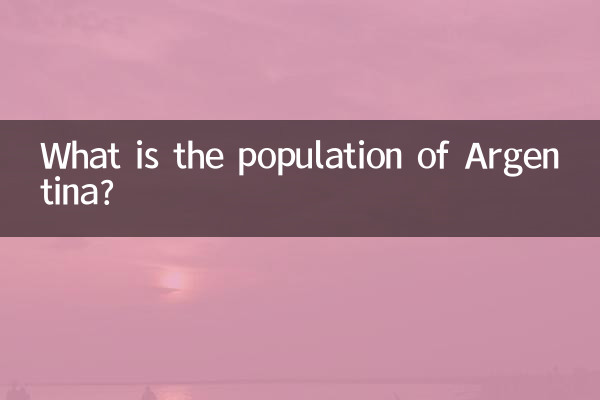What is the population of Argentina?
As the second largest country in South America, Argentina's population has always been the focus of attention from the international community. In recent years, data on Argentina’s population growth trends, age structure, and urbanization levels have sparked widespread discussion. This article will give you a detailed analysis of Argentina’s population status based on the hot topics and hot content on the Internet in the past 10 days.
1. Total population of Argentina

According to the latest statistics, Argentina's population is approximately 46 million. The following is Argentina’s population changes in the past 10 years:
| Year | Population (millions) | Growth rate (%) |
|---|---|---|
| 2014 | 42.7 | 1.0 |
| 2016 | 43.8 | 0.9 |
| 2018 | 44.9 | 0.8 |
| 2020 | 45.8 | 0.7 |
| 2022 | 46.2 | 0.5 |
2. Characteristics of population structure
Argentina’s demographic structure presents the following salient features:
| age group | Proportion (%) | Changing trends |
|---|---|---|
| 0-14 years old | 24.3 | Decline slowly |
| 15-64 years old | 63.5 | Basically stable |
| Over 65 years old | 12.2 | Rising year by year |
3. Urbanization level
Argentina is one of the most urbanized countries in South America, with approximately 92% of the population living in urban areas. The population distribution of major cities is as follows:
| city | Population (millions) | National proportion |
|---|---|---|
| buenos aires | 15.0 | 32.5% |
| Cordoba | 1.5 | 3.2% |
| rosario | 1.3 | 2.8% |
4. Recent hot topics
1.Population aging problem: The proportion of Argentina’s population over 65 years old has exceeded 12%, and the elderly care system is facing severe challenges.
2.Immigration trends: In recent years, the number of immigrants from neighboring countries such as Venezuela and Peru has continued to increase, with approximately 200,000 new immigrants in 2022.
3.Declining fertility rate: Argentina’s total fertility rate has dropped to 2.1, slightly below the population replacement level.
4.Impact of COVID-19: The epidemic has caused a temporary decline in the life expectancy of the Argentine population, falling to 76.3 years in 2021 and rising to 76.8 years in 2022.
5. Future population forecast
According to United Nations projections, Argentina's population will reach about 52 million in 2050, and will then enter a phase of slow decline. The main forecast data are as follows:
| Year | Projected population (millions) | Growth rate (%) |
|---|---|---|
| 2030 | 48.5 | 0.4 |
| 2040 | 50.8 | 0.3 |
| 2050 | 52.1 | 0.2 |
Conclusion
As an important country in South America, Argentina's population development directly affects the regional economic and social pattern. Currently, Argentina is facing challenges such as an aging population and over-concentration of urbanization. Understanding these demographic data will help us better grasp Argentina’s socioeconomic development trends. In the future, the Argentine government needs to formulate more complete population policies to deal with the challenges posed by these structural changes.

check the details

check the details